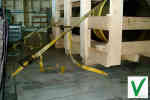Step 2 of 3•4 minutes read
Example of Good and Bad Cargo Securing
Example 1: A mix of Web Lashings and Chain Lashings
Bad Example
Web and chain lashings have very different elongation characteristics and should be mixed only with great consideration. If the cargo unit in this example is subjected to any great forces, the chain will first get tensioned and then possibly snap. Only then will the tension in the web lashing be considerably increased since webbing has much greater elasticity than steel chains.

Avoid mixing chain and web lashings
Example 2: Unsymmetrical Lashing
Bad Example
Two chain lashings have secured the roller in this example at the front, both attached to the same fixed lashing point on the deck. The lashing point is placed away from the unit's centreline. For proper cargo securing, lashings have to be arranged symmetrically on both sides of the cargo unit, with an equal number of lashings.

The lashing point is not in the cargo's centreline
Example 3: Securing the Unit, Not the Package
Good Example
If it is possible to attach lashings directly to the cargo unit, this is always better than making attachments only to the packaging material.

It is the unit, not the dunnage, you need to secure
Example 4: Loose Lashing Equipment
Bad Example
Vehicles should never be parked on lashing equipment. This increases the risk of cargo shifting, and the lashings may cause cargo damage or injure personnel during loading and unloading.

Don't leave loose lashing equipment lying around
Example 5: Corner Protectors
Bad Example
Corner protectors, rubber strips, and other protective materials shall be used to protect webbings from damage caused by sharp edges on the cargo in the picture above.

Protect the lashings from sharp edges
Good Example
Corner protectors, rubber strips, and other protective materials shall be used to protect lashings and cargo from damage caused by sharp edges on the cargo in the picture below.

Protect the cargo and the lashing from sharp edges
Example 6: Lashing Points
Bad Example
Lashings should always be applied to dedicated lashing points on the cargo units. The lashing in the picture on the right does not only threaten to damage the trailer; if the fitting breaks, the whole unit might come loose.

Use dedicated lashing points to avoid cargo shifting and damage
Example 7: Lashings Only Attached to One End of a Cargo Transport Unit
Bad Example
There is no lashing that secures the CTU in the aft end, which means that in bad weather, the CTU can start rolling in a longitudinal direction and also slide in a transverse direction due to lack of lashings.

Lashings attached in the forward end of the CTU

No lashings attached in the aft end of the CTU
Example 8: Combining Lashing Equipment
Bad Example
Placing the sharp hook of roll lash equipment in the hook of ordinary web lashings will cause the latter to split if the lashings are subjected to larger forces in heavy seas. Furthermore, combining lashing equipment with different strengths should be avoided.

Don't combine lashing equipment with different strength
Summary
To secure the cargo properly, it is very important to have a basic knowledge of the principles of cargo securing. Besides understanding the forces that cargo may be exposed to during sea transport and how different lashing methods prevent cargo from sliding and tipping, securing is very much about using common sense to determine what will work and what will not.